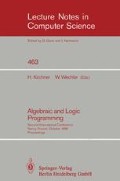Abstract
This paper describes how to model and solve boolean satisfiability problems with the constraint logic programming language CHIP. Although CHIP has not been developed as a specialised propositional calculus prover, it can solve these problems quite efficiently. Several different methods of describing satisfiability problems in CHIP are presented and compared. This flexibility of modelling is a major advantage of CHIP over closed problem solvers. We have evaluated various sets of benchmarks taken from [31] [16] [21]. With one exception, CHIP performs as well or better as specialised programs on these examples. We also shortly discuss an alternative modeling technique using finite domain variables not restricted to 0/1 values.
Preview
Unable to display preview. Download preview PDF.
References
W. Buettner and H. Simonis. Embedding Boolean Expressions into Logic Programming. Journal of Symbolic Computation, 4:191–205, October 1987.
L. Claesen. Proceedings IFIP WG 10.2 WG 10.5 International Workshop on Applied Formal Methods for Correct VLSI Design. Elsevier Science Publishers, Leuven, Belgium, November 1989.
G.B. Dantzig. Linear Programming and Extensions. Princeton University Press, Princeton, New Jersey, 1963.
M. Davis and H. Putnam. A computing procedure for quantification theory. JACM, 7:201–215, 1960.
M. Dincbas, H. Simonis, and P. Van Hentenryck. Extending Equation Solving and Constraint Handling in Logic Programming. In Proceedings of Colloquium on the Resolution of Equations in Algebraic Structures (CREAS), Austin, Texas, USA, May 1987. MCC.
M. Dincbas, H. Simonis, and P. Van Hentenryck. Solving Large Combinatorial Problems in Logic Programming. Journal of Logic Programming, 8(1, 2):74–94, January–March 1990.
M. Dincbas, P. Van Hentenryck, H. Simonis, A. Aggoun, and T. Graf. Applications of CHIP to Industrial and Engineering Problems. In First International Conference on Industrial and Engineering Applications of Artificial Intelligence and Expert Systems, Tullahoma, Tennessee, USA, June 1988.
M. Dincbas, P. Van Hentenryck, H. Simonis, A. Aggoun, T. Graf, and F. Berthier. The Constraint Logic Programming Language CHIP. In Proceedings on the International Conference on Fifth Generation Computer Systems FGCS-88, Tokyo, Japan, December 1988.
W. Dowling and J. Gallier. Linear-Time Algorithm for Testing the Satisfiability of Propositional Horn Formulae. Journal of Logic Programming, 3:267–284, 1984.
G. Gallo and G. Urbani. Algorithms for Testing the Satisfiability of Propositional Formulae. Journal of Logic Programming, 7:45–61, 1989.
M.R. Garey and D.S. Johnson. Computers and Intractability. W.H. Freeman and Company, New York, 1979.
R. Garfinkel and G. Nemhauser. Integer Programming. John Wiley, Chichester, UK, 1972.
T. Graf. Extending Constraint Handling in Logic Programming to Rational Arithmetic. Rapport de stage, DESS-ISI, Sophia Antipolis, France, September 1987.
T. Graf. Raisonner sur les contraintes en programmation en logique. PhD thesis, Université de Nice, France, September 1989. (in French).
ISCAS. Special Session on ATPG. In Proc IEEE Symposium on Circuits and Systems, July 1985.
J-L. Lauriere. A Language and a Program for Stating and Solving Combinatorial Problems. Artificial Intelligence, 10(1):29–127, 1978.
D. Loveland. Automated Theorem Proving. North Holland, 1978.
A.K. Mackworth. Consistency in Networks of Relations. AI Journal, 8(1):99–118, 1977.
R. Manthey and F. Bry. SATCHMO: a theorem prover implemented in Prolog. In Proceedings of the 9th International Conference on Automated Deduction (CADE), pages 415–434, Argonne, Ill, May 1988. Springer.
Ursula Martin and Tobias Nipkow. Boolean Unification — The Story So Far. Journal of Symbolic Computation, 7:275–293, 1989.
A. Rauzy. L'Evaluation Semantique en Calcul Propositionnel. PhD thesis, Universite Aix-Marseille II, Marseille, France, January 1989. (in French).
J. Roth. Diagnosis of Automata Failure: A Calculus and a Method. IBM Journal of Research and Development, 10:278–291, 1966.
K. Sakai and Y. Sato. Boolean Groebner Bases. Technical report, ICOT, Tokyo, Japan, June 1988.
J.H. Siekmann. Universal unification. In 7th International Conference on Automated Deduction, pages 1–42, Napa Valley, CA, 1984.
H. Simonis. Test Generation using the Constraint Logic Programming Language CHIP. In Proceedings of the 6th International Conference on Logic Programming, Lisboa, Portugal, June 1989.
H. Simonis and M. Dincbas. Using an Extended Prolog for Digital Circuit Design. In IEEE International Workshop on AI Applications to CAD Systems for Electronics, pages 165–188, Munich, W.Germany, October 1987.
H. Simonis and M. Dincbas. Using Logic Programming for Fault Diagnosis in Digital Circuits. In German Workshop on Artificial Intelligence (GWAI-87), pages 139–148, Geseke, W.Germany, September 1987.
H. Simonis and M. Dincbas. Solving Propositional Calculus Problems in CHIP. Technical Report TR-LP-46, E.C.R.C. (European Computer-Industry Research Centre), May 1990.
H. Simonis and T. Le Provost. Circuit Verification in CHIP: Benchmark Results. In L.J.M. Claesen, editor, Proceedings of the IFIP TC10/WG10.2/WG10.5 Workshop on Applied Formal Methods for Correct VLSI Design, Leuven, Belgium, November 1989. IFIP, North Holland, Elsevier Science Publishers.
G.J. Sussman and G.L. Steele. CONSTRAINTS-A Language for Expressing Almost-Hierarchical Descriptions. AI Journal, 14(1), 1980.
K. Truemper and F.J. Radermacher. Analyse der Leistungsfaehigkeit eines neuen Systems zur Auswertung aussagenlogischer Probleme. Technical Report FAW-TR-90003, FAW, Ulm, FRG, February 1990. (in German).
P. Van Hentenryck. Constraint Satisfaction in Logic Programming. Logic Programming Series. MIT Press, Cambridge, Ma, 1989.
L. Wos, R. Overbeek, E. Lusk, and J. Boyle. Automated Reasoning. Prentice Hall, Englewood Cliffs, New Jersey, 1984.
Author information
Authors and Affiliations
Editor information
Rights and permissions
Copyright information
© 1990 Springer-Verlag Berlin Heidelberg
About this paper
Cite this paper
Simonis, H., Dincbas, M. (1990). Propositional calculus problems in CHIP. In: Kirchner, H., Wechler, W. (eds) Algebraic and Logic Programming. ALP 1990. Lecture Notes in Computer Science, vol 463. Springer, Berlin, Heidelberg. https://doi.org/10.1007/3-540-53162-9_39
Download citation
DOI: https://doi.org/10.1007/3-540-53162-9_39
Published:
Publisher Name: Springer, Berlin, Heidelberg
Print ISBN: 978-3-540-53162-3
Online ISBN: 978-3-540-46738-0
eBook Packages: Springer Book Archive

